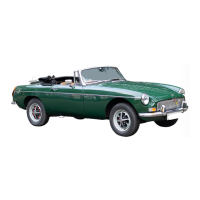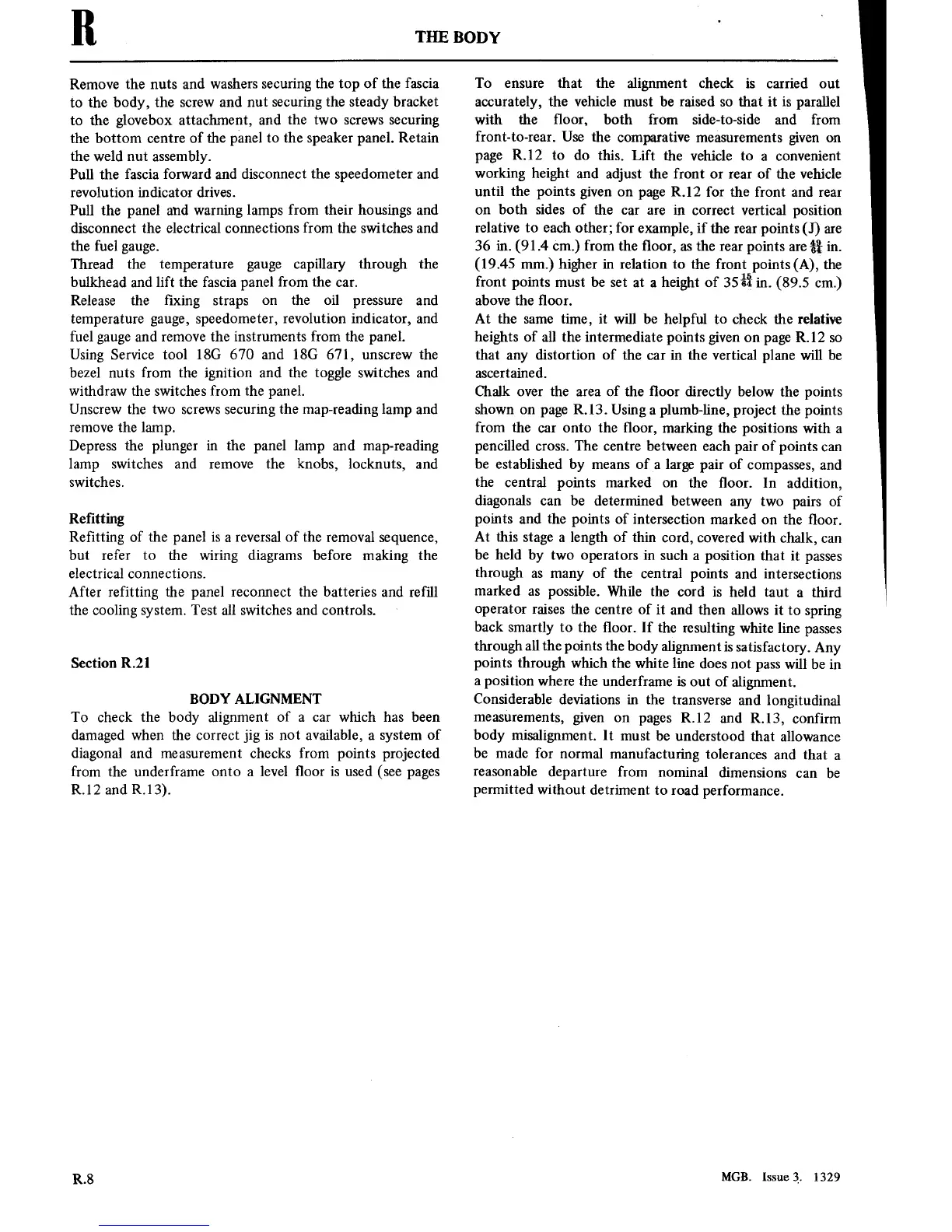B,
THE
BODY
Remove
the
nuts
and washers
securing
the
top
of the fascia
to
the
body, the
screw
and
nut
securing
the steady
bracket
to
the
glovebox attachment, and
the
two
screws
securing
the bottom
centre
of the
panel
to
the speaker panel. Retain
the weld
nut
assembly.
Pull the fascia
forward and disconnect the speedometer and
revolution indicator
drives.
Pull the
panel and
warning
lamps
from their housings
and
disconnect the
electrical
connections
from the switches and
the fuel
gauge.
Thread the
temperature
gauge
capillary
through
the
bulkhead and lift the fascia panel from the
car.
Release the
■xing
straps
on
the oil
pressure
and
temperature
gauge,
speedometer,
revolution indicator, and
fuel
gauge
and
remove
the
instruments
from the
panel.
Using Service
tool 18G 670 and 18G 671,
unscrew
the
bezel
nuts
from the
ignition
and the toggle switches and
withdraw the switches from the panel.
Unscrew
the
two
screws
securing
the map-reading lamp and
remove
the lamp.
Depress
the plunger
in
the panel lamp and
map-reading
lamp switches and
remove
the knobs,
locknuts, and
switches.
Re■tting
Re■tting of the panel
is
a
reversal of the
removal
sequence,
but
refer
to
the
wiring
diagrams before making the
electrical
connections.
After refitting the panel
reconnect
the batteries and refill
the cooling
system.
Test
all switches and controls.
Section R21
BODY ALIGNMENT
To
check the body alignment
of
a car
which has been
damaged when the
correct
jig
is
not
available,
a
system
of
diagonal and
measurement
checks from
points
projected
from the
underframe
onto
a
level
■oor
is
used
(see
pages
R.12 and
R.13).
R.8
To
ensure
that the
alignment
check
is
carried
out
accurately, the vehicle
must
be raised
so
that
it is
parallel
with
the ■oor, both
from side-to-side and from
front-to-rear.
Use the
comparative
measurements
given
on
page
R.12
to
do this.
Lift the vehicle
to
a
convenient
working
height
and
adjust the
front
or rear
of the vehicle
until
the
points
given
on page
R.12 for the front and
rear
on
both sides of
the
car
are
in
correct
vertical
position
relative
to
each other;
for example,
if the
rear
points
(J)
are
36
in.
(91.4
Cm.)
from
the
■oor,
as
the
rear
points
are
■
in.
(19.45 mm.)
higher
in
relation
to
the front
points
(A),
the
front
points
must
be
set at
a
height
of
35%
in.
(89.5 cm.)
above the ■oor.
At the
same
time, it
will
be
helpful
to
check the
relative
heights of
all
the
intermediate
points given
on page
R.12
so
that
any
distortion of
the
car
in
the vertical plane will be
ascertained.
Chalk
over
the
area
of the ■oor
directly below the
points
shown
on page
R.13. Using
a
plumb-line,
project
the
points
from the
car
onto
the ■oor,
marking the
positions
with
a
pencilled
cross.
The
centre
between
each
pair
of
points
can
be established by
means
of
a
large
pair
of
compasses,
and
the central
points
marked
on
the ■oor.
In
addition,
diagonals
can
be
determined between
any
two
pairs
of
points
and the
points
of
intersection marked
on
the ■oor.
At
this
stage
a
length of thin
cord, covered with chalk,
can
be held
by
two operators
in
such
a
position
that
it
passes
through
as many
of the
central
points
and
intersections
marked
as
possible. While
the cord
is
held
taut
a
third
operator
raises
the
centre
of
it
and then
allows
it
to
spring
back
smartly
to
the
floor. If the
resulting white
line
passes
through all the
points
the
body
alignment
is
satisfactory.
Any
points
through
which the
white line
does
not
pass
will be
in
a
position
where the
underframe
is
out
of alignment.
Considerable
deviations
in
the
transverse
and longitudinal
measurements,
given
on
pages
R.12 and
R.13, confirm
body
misalignment.
It
must
be understood
that allowance
be
made for
normal manufacturing
tolerances
and
that
a
reasonable
departure from
nominal dimensions
can
be
permitted
without
detriment
to
road performance.
MGB.
Issue
3.
1329

